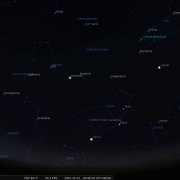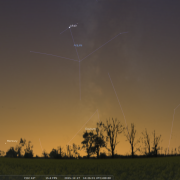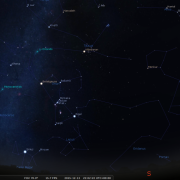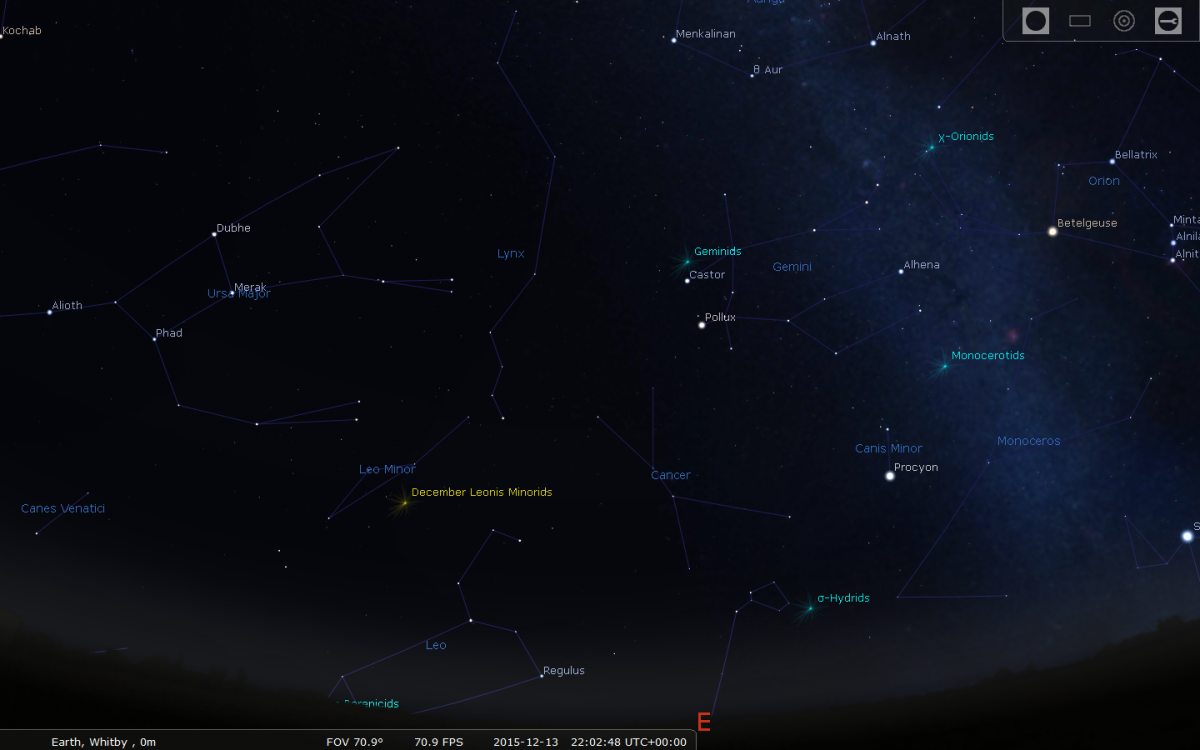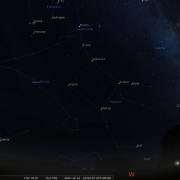In this month's Sky Notes:
- Planetary Skylights
- Meteor Activity
- Giant Meteor seen from Whitby
- Comet C/2013 US10 Catalina
- Winter Solstice
- December 2015 Sky Charts
Planetary Skylights

 Uranus and Neptune continue to be the only major planets visible (with optical aid) in the evening sky. At magnitude 6, binoculars will show Uranus, however only a telescope will reveal its tiny disk. It resides around 1 degree below epsilon Pisces. At almost mag 8 Neptune resides in Aquarius between the two naked eye stars of sigma and lambda Aquarii.
Uranus and Neptune continue to be the only major planets visible (with optical aid) in the evening sky. At magnitude 6, binoculars will show Uranus, however only a telescope will reveal its tiny disk. It resides around 1 degree below epsilon Pisces. At almost mag 8 Neptune resides in Aquarius between the two naked eye stars of sigma and lambda Aquarii.



 Rising in the wee small hours, conspicuous Jupiter resides upper left of Mars and Venus. At the end of last month Jupiter was involved in a spectacular conjunction with Mars and Venus, but already clear blue sky exists between them. Jupiter is a fine telescopic object and unlike Venus has plenty of detail on show. Look for the bands and belts across the disk, the great red spot, which appears quite pale and the attendant Galilean moons next to Jupiter. The Moon lies nearby Jupiter on the 6th By the month’s end Jupiter is rising shortly after midnight.
Rising in the wee small hours, conspicuous Jupiter resides upper left of Mars and Venus. At the end of last month Jupiter was involved in a spectacular conjunction with Mars and Venus, but already clear blue sky exists between them. Jupiter is a fine telescopic object and unlike Venus has plenty of detail on show. Look for the bands and belts across the disk, the great red spot, which appears quite pale and the attendant Galilean moons next to Jupiter. The Moon lies nearby Jupiter on the 6th By the month’s end Jupiter is rising shortly after midnight.
Mars, Venus and finally, Saturn all reside in the dawn sky – lower left of Jupiter. The orange hue of Mars lies to the left of white Spica (chief star in Virgo). Brilliant Venus resides lower left of Mars, not that far above the SE horizon. Turn a scope toward Venus and you will discern a waning crescent phase. The moon lies nearby on the 8th.
 Saturn returns to the dawn sky by the final week in December, look for it around 07:00h lower left of Venus, just above the SE horizon. It is therefore the lowest planet in the chain extending down from Jupiter. The moon lies nearby Saturn on the 10th.
Saturn returns to the dawn sky by the final week in December, look for it around 07:00h lower left of Venus, just above the SE horizon. It is therefore the lowest planet in the chain extending down from Jupiter. The moon lies nearby Saturn on the 10th.
 Mercury has a reasonable evening apparition, but again you will have to wait until the final week to have a decent chance of spotting this elusive planet. Look for it just before 16:30h a few degrees above the WSW horizon.
Mercury has a reasonable evening apparition, but again you will have to wait until the final week to have a decent chance of spotting this elusive planet. Look for it just before 16:30h a few degrees above the WSW horizon.
During the last week of the year, given a clear sky, some sky knowledge and perhaps an alarm clock, you will be able to view all the major planets in one night.
Meteor Activity

Meteor activity reaches a peak at this time of year and given clear skies the chance of spotting a shooting star or two should be quite high. Considered now to be the most prolific annual meteor shower, the Geminids are active from December 7-16th, reaching a peak on December 14th.

Finding Gemenid Meteor Shower (Courtesy: Sky & Telescope Magazine). Peak: 14-Dec-2015
Unlike the majority of meteor showers, which are associated with comet debris, Geminids stem from debris shed by a strange object that may be a dead comet or small asteroid called Phaethon. This object passes within 10 million miles of the Sun and over time has deposited material over great swathes of the inner solar system. However it is only within the last 100 years that Geminid activity has increased to the levels recorded today with Earth passing through a much denser debris strand, a situation that will only last another 100 years!
The shower radiant lies close to Castor, the upper most of the 'twin' stars in Gemini visible in the east by 21:00h. Under ideal conditions the Zenith Hourly Rate (ZHR) can reach 120 plus (early morning hours), however actual observed rates are always lower than this. Prospects this year look good, with the moon setting early evening. After 23:00h on the 13th expect 10-20 per hour, rising to 40-60 per hour by around 02:00h on the 14th when Gemini is at its highest in the sky. The following evening and overnight should also yield reasonable numbers so do keep watch. Concentrate on regions of the sky a couple of hand spans away from Gemini itself. Really bright Geminids can sometimes appear green or orange in hue.
Later in the month the Ursids (active Dec 17-25th) peak on Dec 22/23rd with hourly rates of 8-12 normal. Occasionally Ursids produce strong outbursts. The radiant lies close to the Great Bear.
Meteor lights up the Sky
You may have seen the pictures in the media of a brilliant meteor observed over the North Sea from Whitby on Nov 6th around 01:30h.
Taurid Meteor taken by Peter Horbury over Whitby Foghorn Station (now "Hornblower Lodge")
on Sat 07-Nov-2015 01:30h (Click picture for full image)
Looking at the picture taken by Peter Horbury from the Hawsker Bull (ex foghorn station) the brilliant meteor looked to be around magnitude – 6 in magnitude and had a greenish hue. Apparently Peter was trying to take some time lapse shots of a minor aurora display when the meteor photo-bombed proceedings.
From the trajectory, time and date, the most probable origin of the meteor would be from the Taurid shower, which is active in early November. Did any members see anything?
Comet C/2013 US10 Catalina
 Having passed perihelion on 15th November at a distance of 0.82 AU, Comet Catalina will be become better placed for northern hemisphere observers as it heads north into the early morning sky.
Having passed perihelion on 15th November at a distance of 0.82 AU, Comet Catalina will be become better placed for northern hemisphere observers as it heads north into the early morning sky.
The comet has brightened from Magnitude 7 to Magnitude 5 in the last few weeks and may become a naked eye object. Catalina should certainly be a binocular object at least. As a rough guide, look for the comet in the same part of the sky as Venus, which drops down to the right of Catalina over the course of the first 10 days in December.
We will not see Comet Catalina again for several million years so catch it while you can.
The Winter Solstice
 The Sun reaches its lowest position in the sky on December 22nd this year; the date of the winter solstice, by which time the Sun arcs little more than 12 degrees above Southern horizon at local noon from our latitude. With the northern hemisphere tilted away from the Sun, useful daylight amounts to just 7½ hrs, the shortest day. Latest sunrise and earliest sunset do not however occur on the winter solstice date.
The Sun reaches its lowest position in the sky on December 22nd this year; the date of the winter solstice, by which time the Sun arcs little more than 12 degrees above Southern horizon at local noon from our latitude. With the northern hemisphere tilted away from the Sun, useful daylight amounts to just 7½ hrs, the shortest day. Latest sunrise and earliest sunset do not however occur on the winter solstice date.
The Sun rises latest near the end of December (27 or 28th) and sets earliest mid-month (15 or 16th). Astronomically speaking the winter solstice also marks the first day of winter in the northern hemisphere, but within a few weeks daylight will once again start to lengthen in duration. Now that must be cause for celebration! What shall we call it... any ideas?
|
Looking South
Mid December - 22:00h |
Looking North |
|
Looking East
Mid December - 22:00h |
Looking West
Mid December - 22:00h |
|
Overview
Mid December - 22:00h |
Looking South-East
Mid December - 21:45h |
Additional Image Credits:
- Planets and Comets where not otherwise mentioned: NASA
- Sky Charts: Stellarium Software
- Log in to post comments

